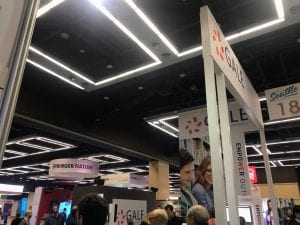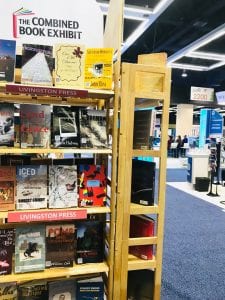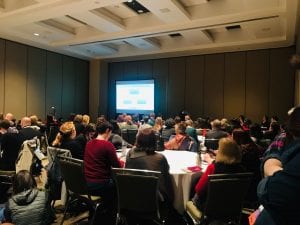
So.Many.Books. So.Many.People.
From January 25th-January 29th, 2019, the American Library Association (ALA) held its annual Midwinter Meeting in Seattle. Across multiple hotels and conference centers, downtown Seattle saw an influx of library workers from public, school, and academic libraries and of vendors promoting books, services, mobile apps, and products, and authors: so.many.authors!


There is no adequate way to encapsulate a professional meeting with over 10,000 attendees, 1,000’s of Advance Reader Copies of books, and 100’s of authors, as well as educational sessions, governance meetings, award announcements, new technology exhibits, and more. And to be honest, every attendee walks away with a different experience.
What can be discussed, however, is the role of these associations in the professionalization of a discipline, and in the edification of its members and practitioners. What can also be discussed — and what we conclude with — is individual experience.
About the ALA/Why Annual Meetings
The first murmurings of a library convention took place in 1853 in New York City. With a few years of inactivity in between,
during the Centennial Exposition in Philadelphia in 1876, 103 librarians, 90 men and 13 women, responded to a call for a “Convention of Librarians” to be held October 4-6 at the Historical Society of Pennsylvania. At the end of the meeting, according to Ed Holley in his essay “ALA at 100,” “the register was passed around for all to sign who wished to become charter members,” making October 6, 1876 the birthday of the American Library Association. (ALA History).
What the founding of an association does is the create a charter with a vision, and unify a body of individuals around a cause. It is an act of professionalization. For the ALA, the charter set forth the following goal for the association and its members:
… promoting [the] library interests [of the country] throughout the world by exchanging views, reaching conclusions, and inducing cooperation in all departments of bibliothecal science and economy; by disposing the public mind to the founding and improving of libraries; and by cultivating good will among its own members. (ALA Charter).
Annual meetings gather people in the same profession together to share in conversation, to learn from another, and to come out with a sense of unity. People go to listen. People go to share their experience and knowledge. They network.

Of course, charters evolve, associations grow, purposes change — as they should. Thankfully, the current member base of the ALA is more diverse than the original founders/members, though there is still much work to be done. Some of the most important sessions of this meeting, in my opinion, were about the work that libraries need to do on Equity, Diversity, and Inclusion within the profession. Transgender Inclusion in Libraries was also a very important panel, and it was a good best practice to see that all gender restrooms were available, that pronoun tags were available, that the traditional land of the Coastal Salish was acknowledged, and that there was ASL interpretation during the major talks.
Impressions
What follows are a few quotes from members of the library staff that attended the ALA Midwinter meetings.
“This was my first ALA conference and I wasn’t sure what to expect. I attended a research conference this summer (Australasian Children’s Literature Association for Research) but knew that the focus on this conference would be on my development as an information services professional. I also knew that this conference would attract approximately 10,000 people, versus the 70 I learned with this summer.
The size came with benefits. Not only was I able to connect with colleagues in my graduate program and library system, but I also got to observe their interactions with the many exhibitors who were selling and supporting a large variety of information services. In one case, I listened as a veteran librarian asked specific questions about recent privacy policy changes in a suite of databases our institution provides for student research. As a librarian, it is important to me that nobody is electronically looking over your shoulder at what you’re looking up, neither for their sales benefit nor to make assumptions about your research motives. It was helpful to watch the librarian-vendor interaction and see how I–as a database customer and an information provider–can demand an explanation of often little-noticed fine print in an imposing legal contract.
From this, I felt empowered to converse with other exhibitors. I found myself asking about diversity in human experience as portrayed through the book covers on display. I challenged a publisher about Native misappropriation via the types of research that underlay an encyclopedia of tribal tattoos. I praised a different publisher for their upcoming youth-oriented book on Alaska Native cultures that included contemporary photos and narratives of children throughout the state.
Upon recounting my events of the day, my partner asked what I hoped to achieve through the conversations on privacy and representation. I told him that I wanted to make sure that vendors and publishers notice that we notice how they’re representing the marketplace and helping us create a safe and inclusive environment for our patrons.” Kari Whitney, Graduate Reference Specialist
“This was my 13th ALA Midwinter conference. It’s a big conference, hovering around 10,000 attendees. (It’s about half the size of the ALA Annual conference!) It was originally conceived of as a conference for committee work. As more committee work has moved online, it has evolved to also enable discussions and professional development.
I often tell new attendees that Midwinter is a set of conferences happening in one shared space. There are lots of different reasons to attend. For example, some people go for the Youth Media Awards and to learn about supporting children. Some attend to learn about bleeding edge news in the profession. I go to attend governance meetings.
My ALA Midwinter was spent facilitating 19 hours of meetings—most of which using parliamentary procedures—and attending another 11 hours of meetings representing ACRL as its President. My President’s Program Committee hosted a terrific program. I filled in any gaps in conversations with colleagues working in academic libraries, public libraries, school libraries, and vendors—all working to provide the best library experience for our patrons from wherever we work. I also met up with several colleagues working on figuring out the next steps of their careers to be a sounding board in their process.
ALA Midwinter was a whirlwind for me, but a successful governance meeting. Now the most important part: bringing the learning that I did back to UW Tacoma, our students, faculty, and staff!” Lauren Pressley, Library Director